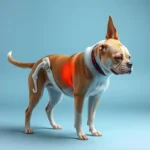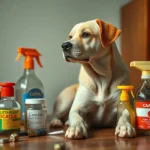
Introduction
When it comes to dog health care, understanding the various phases of a dog’s life is crucial for responsible pet ownership. One significant aspect of dog health that often raises questions is the concept of dogs in heat. This natural biological process is vital for reproduction and can have various implications for a dog’s behavior, health, and overall well-being. This article aims to educate dog owners about the heat cycle, its signs and symptoms, caring for dogs during this time, and addressing common misconceptions.
Understanding the Heat Cycle in Dogs
What is the Heat Cycle?
The heat cycle, also known as the estrous cycle, is a recurring physiological process that female dogs go through, allowing them to reproduce. Understanding this cycle is essential for dog owners, as it affects the dog’s behavior, health, and care needs. Recognizing the signs can help owners manage their pets better and prevent unwanted pregnancies.
Phases of the Heat Cycle
The heat cycle consists of four distinct phases:
-
Proestrus: This phase lasts about 7-10 days and is characterized by initial hormonal changes. During this time, the female dog will show signs of vulvar swelling and may have a bloody discharge, but she will not yet be receptive to male dogs.
-
Estrus: Lasting approximately 5-14 days, this is the period when the female dog is fertile and receptive to mating. Behavioral changes include increased affection, seeking attention from male dogs, and a willingness to mate. The discharge may change in color and consistency.
-
Diestrus: This phase occurs after estrus and lasts about 60-90 days. The dog’s body prepares for a potential pregnancy. If the dog is not pregnant, her body will gradually return to a normal state.
-
Anestrus: This resting phase occurs between heat cycles and can last several months. During this period, there are no visible signs of heat, and the dog’s body recuperates.
Frequency of Heat Cycles
The frequency of heat cycles varies based on breed, age, and individual health. Generally, most dogs will go into heat twice a year, but some breeds may experience more or fewer cycles. Seasonal factors can also influence the timing, so it’s essential for dog owners to be aware of their dog’s specific pattern.
Signs and Symptoms of a Dog in Heat
Physical Signs
Recognizing the physical signs of dogs in heat can be crucial for proper care. Key indicators include:
- Swelling of the Vulva: This is often one of the first noticeable signs that a dog is in heat.
- Blood Discharge: A bloody discharge may be present during the proestrus phase. The amount can vary, and it’s essential to monitor changes.
- Changes in Appetite: Some dogs may experience an increase or decrease in appetite during this time.
Behavioral Changes
Behavioral changes can often be more pronounced during the heat cycle. Common behaviors include:
- Increased Affection or Clinginess: Dogs may seek more attention from their owners and exhibit affectionate behaviors.
- Seeking Attention from Male Dogs: Female dogs in heat will often attract male dogs and may try to escape to find them.
- Nesting Behavior: Some dogs exhibit nesting behavior, which includes gathering items to create a comfortable space.
Duration and Timing of Symptoms
Symptoms typically last 2-3 weeks, with the most intense behaviors occurring during the estrus phase. Understanding the timing within the heat cycle helps in managing the dog’s environment and interactions with other pets.
Caring for a Dog in Heat
Basic Care Needs
Caring for a dog in heat involves several essential practices:
- Maintaining Hygiene: Clean the area around the vulva regularly to manage discharge and prevent infections. Dog diapers can also be helpful for keeping the area clean.
- Ensuring a Safe and Comfortable Environment: Provide a quiet space where your dog can feel safe, especially if she seems anxious or restless.
- Importance of Regular Exercise: Regular walks and play are crucial, but be cautious about interactions with male dogs during this time.
Managing Interactions with Male Dogs
Keeping dogs separated during this time is vital to prevent unwanted mating:
- Best Practices for Separation: Keep your female dog indoors or on a leash when outside. Avoid dog parks or areas where male dogs may be present.
- Risks of Unwanted Mating and Pregnancy: Allowing male dogs access can lead to unplanned pregnancies, which can complicate both the dog’s and owner’s lives.
Veterinary Care During Heat
Consulting a veterinarian is essential for maintaining a dog’s health during the heat cycle:
- When to Consult a Veterinarian: If you notice any unusual symptoms, such as excessive bleeding or signs of distress, contact your vet immediately.
- Vaccinations and Preventive Care: Ensure your dog is up-to-date on vaccinations and discuss any preventive care options with your veterinarian.
Health Risks Associated with Dogs in Heat
Pyometra
One of the most significant health risks for female dogs is pyometra, a severe infection of the uterus:
- Definition and Symptoms: Pyometra typically occurs in older, unspayed females and can be life-threatening. Symptoms include excessive thirst, lethargy, and abnormal discharge.
- Importance of Spaying: Spaying your dog significantly reduces the risk of pyometra and other reproductive health issues.
Other Reproductive Health Issues
In addition to pyometra, female dogs in heat can face various other reproductive health issues:
- Hormonal Imbalances: These can lead to irregular heat cycles and other health concerns.
- Cysts and Tumors: Hormonal changes can also result in the development of cysts or tumors in the reproductive tract.
Importance of Spaying and Neutering
Spaying and neutering are crucial for responsible pet ownership:
- Benefits for Health and Behavior: Spaying can prevent many health issues and reduce certain behavioral problems, such as aggression and roaming.
- Recommended Timelines for Spaying/Neutering: Consult your veterinarian for personalized recommendations based on your dog’s breed and age.
Myths and Misconceptions About Dogs in Heat
Common Myths
Several myths surround dogs in heat, often leading to confusion among pet owners:
- Misunderstandings About Mating Behavior: Some owners believe that dogs in heat will automatically mate if given the chance, but this isn’t always the case.
- Beliefs About Spaying and Its Effects: Many people think spaying will change their dog’s personality or make them gain weight, which is not necessarily true.
Debunking Myths
It is essential to provide factual information to counter these myths:
- Providing Factual Information: Educating dog owners about the realities of the heat cycle and the benefits of spaying can help dispel common misconceptions.
- Importance of Educating Dog Owners: Knowledge is power, and informed pet owners can make better decisions regarding their dog’s health.
Conclusion
Understanding dogs in heat is a vital aspect of dog health care. By recognizing the signs, managing care, and being aware of potential health risks, dog owners can ensure their pets remain healthy and happy during this natural biological process. Prioritizing dog health care ultimately leads to a better quality of life for both the dog and the owner.
FAQs
What should I do if my dog is in heat?
Monitor her behavior and ensure she is kept away from male dogs to prevent unwanted mating. Maintain hygiene and consult your veterinarian if you have any concerns.
How long does a dog stay in heat?
The heat cycle typically lasts about 2-3 weeks, with the most noticeable symptoms occurring during the estrus phase.
Can I spay my dog while she is in heat?
It is generally recommended to wait until the heat cycle is over before spaying, but consult your veterinarian for specific advice tailored to your dog’s circumstances.
Will my dog’s behavior change when she is in heat?
Yes, many dogs exhibit behavioral changes during their heat cycle, including increased affection and restlessness.
What are the risks of not spaying my dog?
Not spaying can lead to health issues such as pyometra and increase the risk of unwanted pregnancies and behavioral problems.









